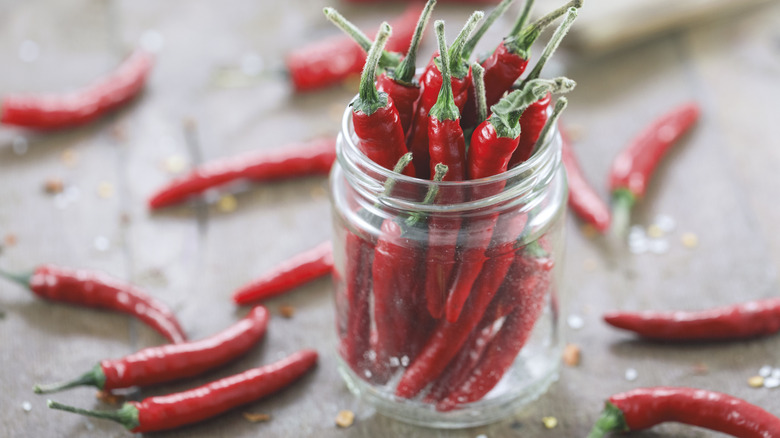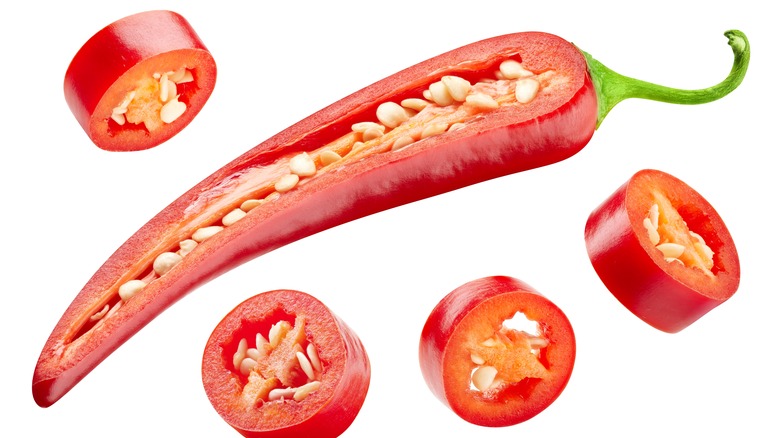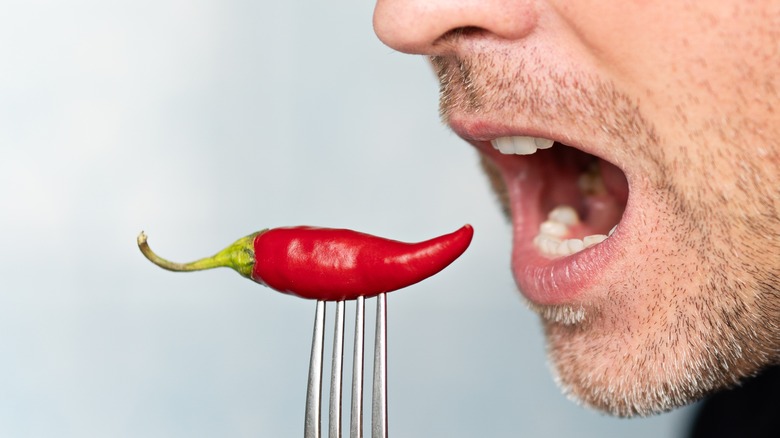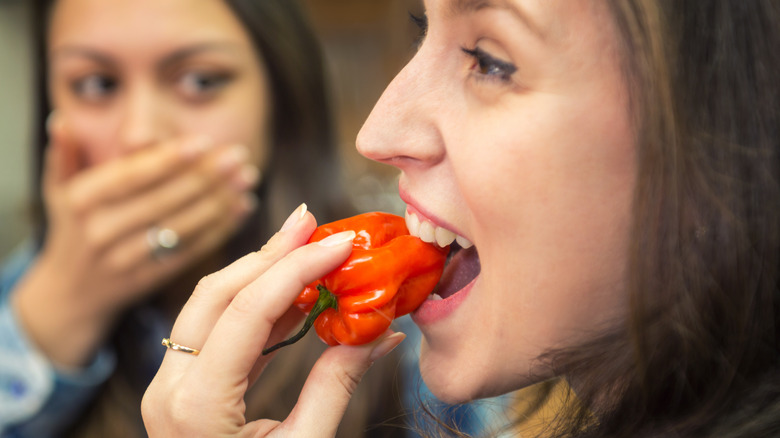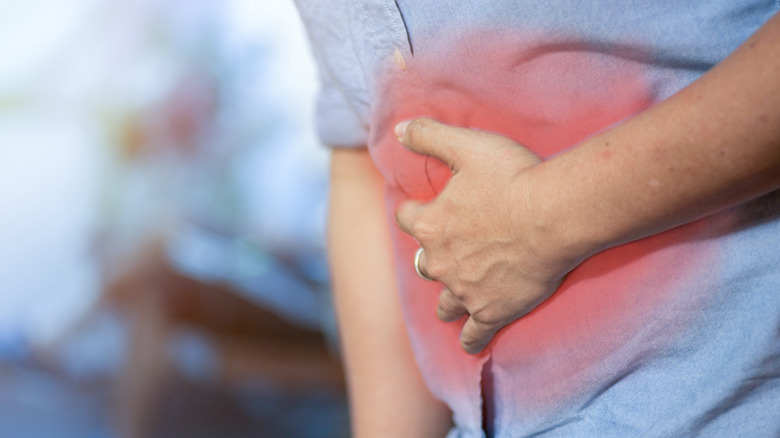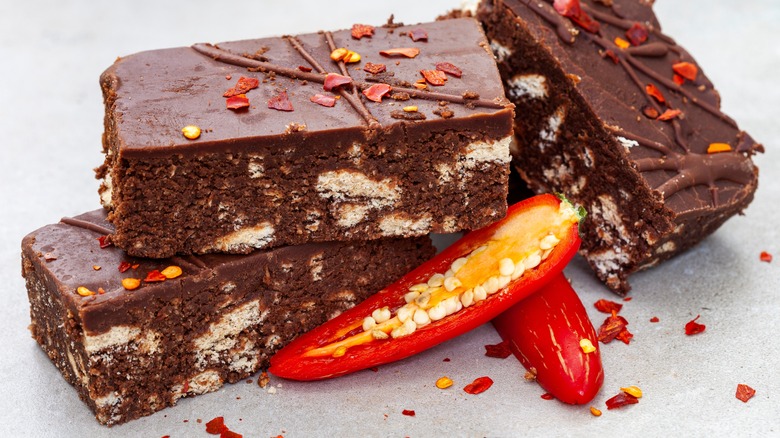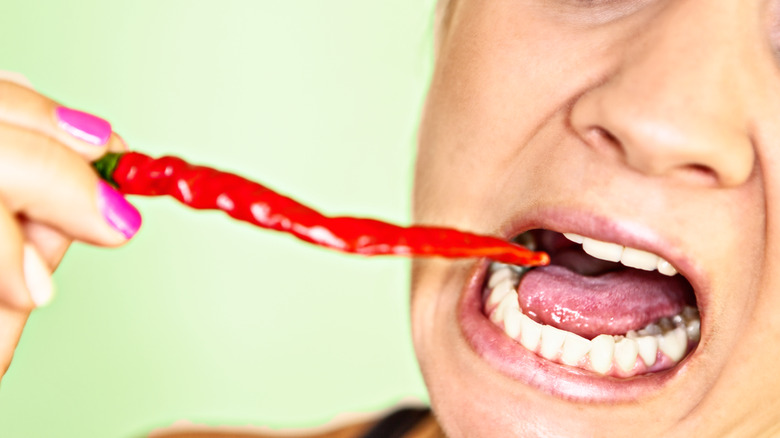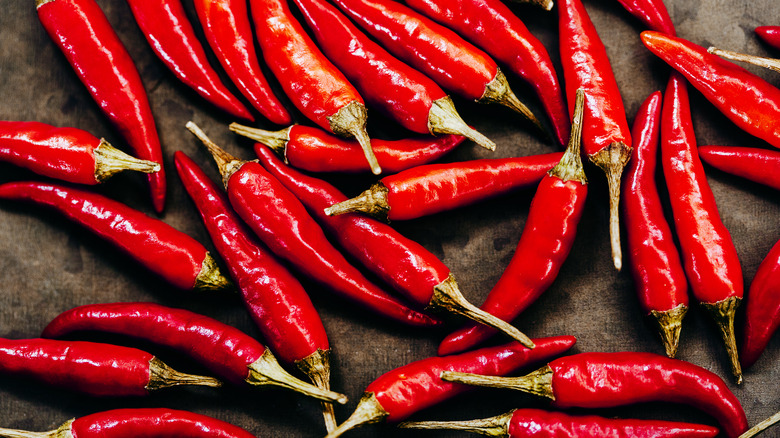12 Spicy Food Myths Debunked
Spicy foods are certainly up there as one of the most polarizing types of cuisine. While some of us love to go all out with the fieriest sauces, marinades, and spice rubs we can find, others prefer to keep their dishes free of even the faintest whisper of spice. From the searing heat of a habanero to the subtler kick of a jalapeño, there's a whole world of spicy foods out there to captivate your taste buds, if you can handle the heat!
No matter where you stand in the spice debate, you might've heard a rumour or two about the qualities of chili peppers and other spicy ingredients, as well as the potential consequences of eating them. However, many of these claims are nothing more than myths. Have you ever been told that eating hot peppers will kill your taste buds, or heard the age old myth that they can help to induce labor? Well, both are frankly wrong and there are plenty more unfounded claims where those came from.
We're here to debunk the many myths that surround these fiery foods. So, whether you're here to confirm your suspicions or to learn something new, it's time to brush up on your spice knowledge as we explore the reality behind the myths.
1. Myth: The hottest part of a pepper is the seeds
When using chili peppers in our recipes, we're often instructed to remove and discard the seeds when chopping it up. This is meant to reduce the heat level, yet it's not actually these seeds that are the hottest part of the pepper.
Capsaicin, the chemical compound responsible for the heat in chili peppers, is primarily found in the placenta of the chili. This is the white pith or rib that holds the seeds inside the pepper. This contains the highest concentration of capsaicin, instead of the seeds themselves. When we feel that burn after eating a chili, this is due to capsaicin binding with heat-detecting receptors in our mouths.
While the seeds may appear to taste extremely hot, the reduction in heat we experience from their removal is likely due to the fact that we're cutting away the placenta at the same time. But this misconception persists, likely because the seeds are often the most visible thing inside a chili. So, next time you're looking to reduce the spice level of a dish, take care to slice away all of that white pith and don't worry so much about the seeds. This can be done quickly and very effectively by using a simple teaspoon.
2. Myth: Eating spicy foods will kill your taste buds
Another myth surrounding spicy foods is their effect on our taste buds. Some throw around claims that eating hot peppers could cause permanent physical damage to the part of our body. This is completely untrue. The burning sensation caused by capsaicin (the active component in chili peppers) is temporary and will not cause long-term harm to your taste buds.
When you eat spicy food, capsaicin binds to the TRPV1 receptors on your tongue. These are a type of pain receptor and the same ones responsible for detecting foods and drinks that are too hot to consume, in terms of temperature. The binding of capsaicin sends a signal to your brain, tricking it into thinking your mouth is burning, and resulting in pain.
However, this sensation is temporary and gradually fades as the capsaicin is washed away by saliva or neutralized by other foods and drinks. Sometimes, the taste receptors can become desensitized for a few days after eating a particularly spicy meal, which can result in a temporarily increased spice tolerance. Your taste buds are also remarkably resilient and are constantly regenerating, with a life cycle of about 10 days. This means they're particularly adept at repairing damage.
3. Myth: Spicy foods can induce labor
Amongst expectant parents, there's a long-standing rumour that eating spicy foods can help induce labor. It's a myth that's been passed down through generations, with many pregnant people still avoiding spicy foods during pregnancy, or loading up on the chilis to try and get things going if their due date has already passed.
Despite this belief, there is no sufficient evidence to support the supposed labor-inducing effects of spicy foods. However, eating a fiery meal can affect your digestive system by causing heartburn, indigestion, or even abdominal cramps that could be mistaken for labor contractions. However, these symptoms will not kick-start labor. In fact, there are some positives that come with chowing down on chilis if you're pregnant. The capsaicin in peppers has been found to have immune-boosting and anti-inflammatory properties, so there's no need to hold back on the heat during pregnancy unless your doctor tells you otherwise.
Medical professionals agree that there is no definitive food that can induce labor. While some anecdotal reports claim success with spicy foods, these are more likely coincidences rather than direct causes. True labor is initiated by hormonal shifts and physical changes in the body, not by the food you eat. So, if you're nearing your due date and eager to meet your baby, it's best to rely on medical advice rather than spicy myths.
4. Myth: Everyone is born with the same spice tolerance
Put simply, we are not all born with the same level of spice tolerance. While our exposure to spice can absolutely build that tolerance over time, we don't all start out with the same baseline.
Genetically, people have different levels of sensitivity to the capsaicin found in chili peppers. This sensitivity is influenced by the number of TRPV1 receptors, which detect heat and pain, present on the tongue. Some people have more of these receptors, making them more sensitive to spicy foods, while others have fewer and therefore a higher tolerance for spice.
Though genetics can have a significant impact on our tolerance, environmental factors are very much in play, too. In many cultures where eating spicy foods is commonplace, people tend to develop a higher tolerance from a young age due to this repeated exposure. Regularly exposing TRPV1 receptors to heat can gradually decrease their sensitivity over time. This helps to explain why someone from a country with typically spicy cuisine can often handle heat better than another person from a place where spicy food is less common.
5. Myth: Spicy foods are addictive
It's a claim that's often thrown around by heat enthusiasts, but spicy foods are not actually addictive. Although many of us crave a spice-loaded curry or deem our meals incomplete without a generous drizzle of hot sauce, there is no evidence that chilis have truly addictive properties.
The feeling of heat we experience when eating spicy food does trigger the release of endorphins and dopamine in the brain. Endorphins are natural painkillers and dopamine is a mood-boosting neurotransmitter. This combination can create a feeling of euphoria, which might lead you to repeatedly seek out the sensation.
Although this process might sound very much like addiction, the tempting nature of chilis is instead associated with one's desire to repeat a pleasurable experience. True addictions involve a compulsive need for a particular substance or activity, tolerance (needing more of the substance to achieve the same effect), and decidedly physical and mental withdrawal symptoms when that substance is no longer available. Even though people might crave spicy foods and even build up a tolerance, they do not experience withdrawal symptoms in the absence of spicy foods.
6. Myth: Drinking water will relieve the pain of a spicy mouthful
When we eat spicy foods, our bodies response is to try and cool us down, which is why enjoying a particularly fiery meal might leave us feeling a little sweaty. This sensation of overheating also makes reaching for a cooling glass of water seem like a logical idea. But this is a classic mistake that unfortunately does little to alleviate the burning sensation.
That's because the capsaicin responsible for that burn is hydrophobic, which means it doesn't dissolve in water. Instead, it clings to oil and fat. When we drink water, this can actually spread the capsaicin around your mouth, potentially intensifying the burning sensation rather than soothing it.
To effectively neutralize the heat, you need something that can get that capsaicin out of your mouth. That's where dairy products like milk, yogurt, or ice cream can come in handy. These products contain casein, a protein that breaks down the capsaicin and helps to wash it away. This is why a glass of milk is often recommended to cool down after a spicy meal. Similarly, swirling some oil around your mouth before spitting it out can help mitigate the burn.
7. Myth: Spicy food can cause ulcers
While spicy foods can temporarily irritate the mouth, they are not the culprit behind ulcers. Ulcers are sores that can develop in the mouth as well as on the lining of the stomach or small intestine and, despite common claims, there is no medical evidence that eating spicy food will increase your risk of developing them.
Research suggests that most gastric ulcers are caused by either an infection with the Helicobacter pylori (H. pylori) bacteria or the frequent use of nonsteroidal anti-inflammatory drugs (NSAIDs) like aspirin and ibuprofen. NSAIDs can irritate the stomach's protective lining, while H. pylori causes inflammation and makes the stomach more susceptible to damage. When it comes to mouth ulcers, these are typically caused by infections or trauma, like accidently biting the inside of your cheek when eating (hey, we've all been there).
While spicy foods won't cause these sores to form, it is true that they can cause discomfort or exacerbate symptoms in people with pre-existing ulcers. So, it might be best to turn down the heat if you're ulcer-prone.
8. Myth: There isn't any major variation in heat between peppers of the same variety
When grabbing your favorite chili peppers at the store, it would be logical to assume that if you stick to one variety, you should get with the same level of heat every time. Actually, this isn't entirely true. The heat level of peppers can vary significantly even within the same species.
A key factor that influences the heat of a pepper are its growing conditions, such as soil quality, drainage, and temperature. Peppers grown in hotter, sunnier climates tend to be spicier than those grown in milder conditions. Additionally, the maturity of the pepper will affect its spiciness, with peppers generally becoming hotter the more they are allowed to ripen.
An excellent example of this variation involves jalapeño peppers. The heat of a chili pepper is measured in Scoville heat units (SHU), which can range from zero for mild bell peppers to over 3 million for the world's hottest chili. For jalapeños, their SHU sits anywhere between 2,500 to 8,000, which is why you might find that two jalapeños from the same produce section have noticeably different heat levels.
9. Myth: Only savory foods should be spicy
Spicy peppers are a key ingredient in many beloved savory dishes. But it's not just curries, stews, and meat rubs that can benefit from the addition of some fiery flavor. Many sweet treats can also be enhanced with the help of a little spice.
Adding a kick to desserts and drinks can be an excellent way to balance out the sometimes intense sweetness in some treats. For example, Mexican hot chocolate is a popular recipe that is typically made with a pinch of chili powder. This adds a warming touch that enhances the wonderful richness of the cocoa. Cayenne pepper and ancho chili powder can also join the mix for chocolate brownies, merging gooey, fudgy chocolate with the fiery heat of the peppers.
Spicy ingredients are also a popular addition to candied nuts, such as walnuts or pecans. To make these, heat the nuts in a saucepan along with sugar, water, salt, chili powder, and cinnamon until they're coated in a spicy syrup. Then, bake them on a well-greased baking sheet until fragrant and toasty.
10. Myth: Spicy food can cure a cold
When we're feeling under the weather with an unpleasant runny nose and congestion, we'll do just about anything to get relief. Eating spicy food often suggested to those suffering with a cold, but how effective is this really?
In truth, spicy food cannot cure the underlying infection that brings on a cold. The common cold is caused by a variety of different viruses. Our immune system springs into action to fight this virus off, sending out white blood cells and creating an inflammatory response. Eating spicy foods has no impact on this process.
Despite this, spicy foods can temporarily alleviate some cold symptoms. Capsaicin can help relive nasal congestion by stimulating mucus production, which means the nasal passages get flushed out and breathing feels a little easier. Furthermore, capsaicin has analgesic properties that might help soothe a sore throat and headache. But these forms of relief are usually temporary and will not address the root cause of the cold. The best way to aid your recovery is with plenty of rest and proper hydration.
11. Myth: Eating hot chili peppers can cause long term damage
If you've ever watched a hot pepper eating competition, you've likely witnessed some of the alarming symptoms that come from biting into a chili. There's no question that these fiery peppers can cause a whole lot of discomfort but despite this initial intensity, eating them will not cause any lasting damage to the body.
The more capsaicin in a pepper, the hotter the eating experience will be as more receptors are activated in the mouth. Most of the common chilis we find in grocery stores are unlikely to cause severe symptoms, but those at the scarier end of the Scoville scale can have pretty unpleasant effects for some eaters, such as extreme stomach pain and vomiting. This alarming response occurs because our pain receptors perceive the chili the same as an actual burn. Essentially, the body is doing everything it can to get us to stop eating this potentially dangerous substance.
Typically, these nasty symptoms subside within a day or so and have no lasting effects on the body. So, while the fieriest of peppers are probably best avoided unless you want to deal with the immediate aftermath, there's no reason to fear enjoying spicy food in a way that suits your tolerance. In fact, upping the heat might just extend your life, with those who frequently eat spicy food having a 14% chance of living longer than those who don't, as per a 2015 study published in BMJ.
12. Myth: Chili peppers are always hotter when raw
Fresh, vibrant, and crisp, something about a raw chili pepper makes it appear spicier than its cooked counterpart. However, a raw pepper is not necessarily the hottest form of the fruit (yes, peppers are botanically classified as fruits).
Capsaicin is a relatively heat stable compound, which means it doesn't degrade significantly with cooking. But the way capsaicin interacts with your taste buds can change depending on how the pepper is prepared. The heat involved with cooking will often break down the peppers, releasing capsaicin more evenly throughout the dish. This can sometimes make the heat seem more intense because the capsaicin is now more uniformly distributed.
On the other hand, roasting or grilling peppers on their own can actually mute their fiery nature, since these higher-heat cooking methods are capable of breaking down capsaicin. Prolonged cooking, particularly if making spicy broths or stews, can also reduce the spice level of a dish as some of the capsaicin is carried away in steam.
